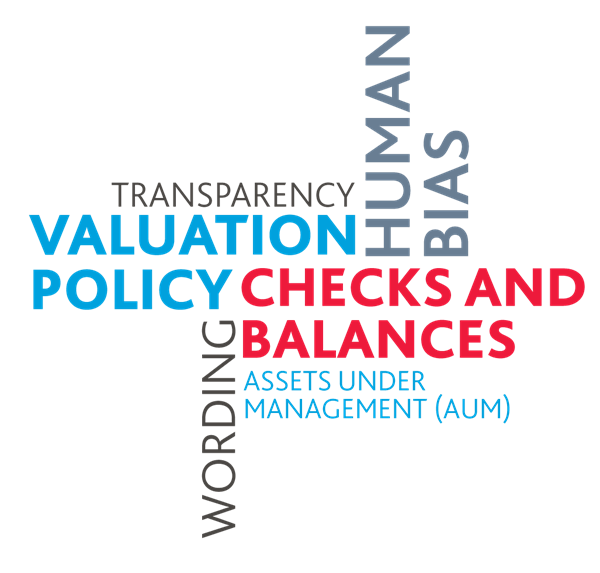Curbing human bias in investment valuation

Five years ago, it was not uncommon to hear about investment managers not having a customized valuation policy to go along with their investment policy statements.
Thankfully, this is not the case so often anymore: Nowadays, most asset managers have a framework describing how and when they will determine the value of the assets in a portfolio and track that value over time.
Having an effective valuation policy in place is critical because human beings, including asset managers, are biased.
For instance, compensation may be based on assets under management (AUM) or growth during a certain time frame, and this could make it appealing to book all gains in one period to get a higher bonus that period.
Or it may be beneficial for tax reasons to hold the assets at cost until sold. Whatever the reason, without an effective valuation policy in place, asset managers could be tempted to make those transactions benefiting themselves most, instead of the investor. Or, as it happened in numerous example during the 2007 downturn, managers may hold investments at cost without reflecting significant market losses in their value.
In my debut article on this channel, I’d like to discuss three ways to make sure your valuation policy is the best it can be, not only because of human bias but also because effective valuation policies help build trust in the financial system.
#1 - Consider the wording of your valuation policy
My first point is about the language you select for your valuation policy. It needs to be clear and accurate, but it also needs to leave the asset manager with some flexibility. For instance, if an asset manager typically uses market multiples for valuations, but those multiples aren’t available for a given period, the asset manager needs other options. This can happen when industries consolidate or a downturn comes.
In this case, wording along these lines would be good: “When valuing assets, we consider commonly used valuation methodologies, including the income approach and the market approach, and we determine which would be the most appropriate for a particular time period.”
With this phrasing, the valuation policy also protects the asset manager as well as the investor, and this is important if the manager is working with complex or hard-to-value assets, such as Level 3 assets. (The Financial Accounting Standards Board (FASB), in FASB 157, requires all publicly-traded companies in the United States to classify their assets on the certainty with which fair values can be calculated, with Level 3 being the most difficult. Often, Level 3 assets are very illiquid, and fair values can only be calculated using estimates or risk-adjusted value ranges).
My point here is the: The valuation policy should be designed to keep valuation methods consistent but also support asset managers if they need to switch methods from the previous period for a valid reason.
#2-Get the right people on your valuation committee
A common “mistake” or drawback I see in valuation policies is to have a single person in charge of valuations. Therefore, my second point: Consider a committee instead. Having a committee allows your valuation to be more nuanced. (This might also mean you need more documentation to back up the committee’s decision, but you benefit from flexibility in your approach).
Strong committees include someone representing the investment and providing information about it; the people doing the valuation of the investment; and an independent party who can review the valuation without an investment manager’s bias.
Building on such a committee, your company can also add someone from finance and accounting who knows how the valuation will impact the financial statement. And it’s great to have a big-picture person on the committee, such as the CFO who can look at the risk of holding the investment without having the bias of being the one who purchased it (and therefore needs to defend that decision).
#3 – Add a third party to the valuation committee
Often, with so-called “hard to value” assets, a valuation committee will ask another independent party to double check its work on a quarterly or annual basis. This is common practice among big-asset managers even if the committee already includes an independent member.
In one project, we were hired to look at a client’s trades and make sure they were being marked correctly. We found that the municipal bonds held by the client didn’t show the decline in the market value that had impacted the industry. The fee structure was assets under management, and the investment manager was getting way more fees than he should have. We looked at about 400 securities from the previous four years and noted some securities with large variances in their value, compared to actual market value.
For me, this was a clear case of ego, where the manager did not want to show the decline in value and used the valuation policy to paint a prettier picture. Here, a third party would have been helpful. Commissions were also a factor, but what good does that do the investment manager now: That company is gone and the manager lost his job.
In conclusion, the right wording for valuation policies, the right roles on valuation committees, and third-party independent assessments of valuations can lead to more transparent results and therefore more trust in the financial system.
I understand that people need to justify their actions in hindsight, and if an investment manager makes a decision that goes wrong, he or she may look to valuation methods to present the results in a more favorable light.
That’s human nature. And that’s exactly why the best practice is checks and balances.